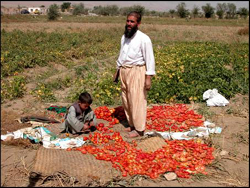
Photo: Matt Herrick
Nadir, a farmer in Baghram, says his irrigation has improved significantly in 2003, even at 6.5km from the Ghorband dams.
|
Results
The project is 95% complete and has already benefited nearly 300,000 people in 82 villages by increasing canal-irrigated land by nearly 40 percent. Community meetings held by the local mirab, or water man, has assuaged concerns over water rights and produced a respected schedule of canal maintenance by area farmers.
The program’s impact has changed the lives of many Afghan villagers, considering that nearly 75 percent of returnees in 2002 — mostly from Pakistan and Iran who fled during the Taliban government — did not have farmland. Having helped to build the irrigation system, the villagers can return to their primary method for earning income — farming. In 2003, wheat production in Parwan increased by 30 percent and corn production by over 11 percent.
Print-friendly version of this page (235kb - PDF)
|


